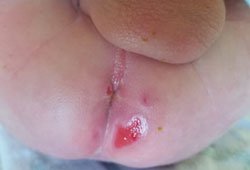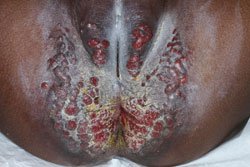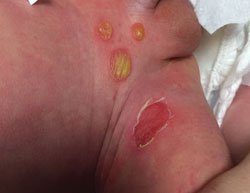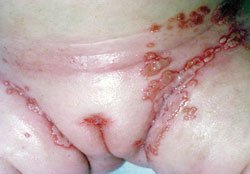Infant presents with severe diaper dermatitis

A 4-week-old male is being seen for a 3-week history of severe diaper dermatitis. The rash has been treated with clotrimazole and a barrier cream, with some improvement about a week ago. However, three discrete, erosive lesions subsequently developed, along with a low-grade fever of 100.6°F that was documented in the ED. Due to the fever, the baby was admitted to the hospital for a sepsis workup that included a blood culture; urinalysis and urine culture; a wound culture of the larger lesion; and a herpes simplex PCR. The baby was empirically started on therapy with ampicillin plus gentamicin. A lumbar puncture was attempted but was unsuccessful, and it was later deemed unnecessary and therefore was not reattempted.
Examination revealed normal vital signs in the hospital, with no further fevers noted. The exam was that of a completely normal 4-week-old male except for three discrete, various-sized, raw-appearing perianal lesions (Figure 1). There also appears to be some slight erythema to the surrounding skin. The lab tests noted earlier were all normal with no positive culture or PCR.
What’s your diagnosis?
A. Granuloma gluteale infantum
B. Erosions secondary to long-standing diaper dermatitis
C. Severe Candida albicans dermatitis
D. Staphylococcal scalded skin syndrome

Source: James H. Brien, DO.
Case Discussion
Due to the somewhat unusual nature of these lesions, a pediatric dermatology consult was obtained. The opinion of the dermatologist was choice B — erosions secondary to long-standing diaper dermatitis. With attention to good skin care (hygiene and drying), as well as topical antifungal cream and barrier ointment, the problem was completely resolved at the 2-week follow-up.

Source: James H. Brien, DO.
Granuloma gluteale infantum (Figure 2) is a rare condition of uncertain etiology that dates back to at least the late 19th century. In the mid-20th century, it was referred to as vegetating potassium bromide toxic dermatitis because of its association with long-term use of this product for diaper rashes. A more popular theory implicates the overuse of potent steroids and/or a local reaction to C. albicans. Whatever the cause, it is self-limiting, requiring no specific treatments other than just good hygiene and to discontinue the use of steroids and other topical medications. The patient who presented may have actually had the early manifestations of granuloma gluteale infantum. I’m not sure that a biopsy would be able to distinguish between the two. They both get better with meticulous skin care. For a more detailed review of this unusual condition, I would refer you to my November 2012 column.

Source: James H. Brien, DO.
Severe Candida diaper dermatitis is shown in Figure 3. This results from the combination of heavy colonization with C. albicans and skin breakdown due to contact dermatitis caused by irritants in stool and urine. The case shown in Figure 3 is admittedly unusually severe, identified in a baby with underlying seborrheic dermatitis, but it also demonstrates the satellite lesions common with this condition. In fact, if one looks for the organism, it is more likely to be found in one of these satellite lesions. For more information about this, I would refer you to my March 2004 column.

Source: James H. Brien, DO.
Langerhans cell histiocytosis (LCH) is a well-recognized cause of persistent “diaper rash.” However, it does not stop in the diaper area but more likely involves the entire skin. It can be seen in the newborn period but is usually diagnosed later (Figure 4), and it carries an ominous prognosis in the most severe form (Letterer-Siwe disease), which may consist of multiorgan involvement, including defects in the bones and pulmonary infiltrative disease (this is the usual cause of death in those who do not survive). Diagnosis is usually confirmed by biopsy and best managed by oncology. For more on LCH, I would refer you to my August 2010 column.

Source: James H. Brien, DO.

Source: James W. Bass, MD.
There are obviously other conditions that can appear on the skin of babies in diapers. Last month, I featured a case of bullous impetigo in the diaper area (Figure 5), and a case of eczema herpeticum is shown in Figure 6.
Reference:
Steele RW, Bass JW, Margileth MD. Atlas of Pediatric Infectious Diseases. New York: The Parthenon Publishing Group; 1999, The Encyclopedia of Visual Medicine Series.
For more information:
James H. Brien, DO, is with the department of infectious diseases at McLane Children’s Hospital, Baylor Scott & White Health, and an adjunct professor of pediatrics at Texas A&M College of Medicine in Temple, Texas. He also is a member of the Infectious Diseases in Children Editorial Board. Brien can be reached at jhbrien@aol.com.
Disclosure: Brien reports no relevant financial disclosures.
Columnist Comment: You may have noticed that I have referenced James W. Bass (1930-2001) for his picture collection or guidance many times over the years. Prior to his death, he collaborated with Russell Steele, MD, and Andy M. Margileth, MD, to publish a nifty (that’s right, nifty) Atlas of Pediatric Infectious Diseases in 1999. Many of his classic pictures, along with those of Andy Margileth and Russell Steele, can be found there, along with a brief comment of each. This book can still be purchased online. At just over 100 well-indexed pages, I find it very handy and convenient.
Please remember our soldiers, sailors, marines and airmen stationed all over the world this Thanksgiving. Since 1776, they remain our most tangible connection to our freedom.
